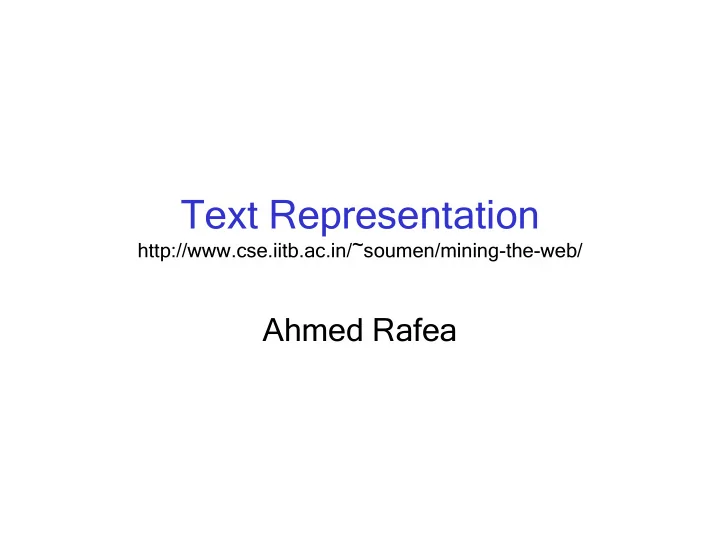

Text Representation http://www.cse.iitb.ac.in/~soumen/mining-the-web/ Ahmed Rafea
Text Representation Document Preprocessing Vector Space Model for Document Storage Measure of Similarity 2
Document preprocessing(1/3) Tokenization • Filtering away tags • Tokens regarded as nonempty sequence of characters excluding spaces and punctuations. • Token represented by a suitable integer, tid , typically 32 bits • Optional: stemming/conflation of words • Result: document (did) transformed into a sequence of integers ( tid, pos ) 3
Document preprocessing(2/3) Stopwords • Function words and connectives • Appear in large number of documents and little use in pinpointing documents • Issues Queries containing only stopwords ruled out Polysemous words that are stopwords in one sense but not in others – E.g.; can as a verb vs. can as a noun 4
Document preprocessing(3/3) Stemming • Remove inflections that convey parts of speech, tense and number • E.g.: university and universal both stem to universe. • Techniques morphological analysis (e.g., Porter's algorithm) dictionary lookup (e.g., WordNet ). • Stemming may increase the number of documents in the response of a query but at the price of precision It is not a good idea to stem Abbreviations, and names coined in the technical and commercial sectors E.g.: Stemming “ides” to “IDE”, the hard disk standard, “SOCKS” firewall protocol to “sock” worn on the foot, may be bad ! 5
The vector space model (1/4) Documents represented as vectors in a multi-dimensional Euclidean space • Each axis = a term (token) Coordinate of document d in direction of term t determined by: • Term frequency TF(d,t) number of times term t occurs in document d, scaled in a variety of ways to normalize document length • Inverse document frequency IDF(t) to scale down the coordinates of terms that occur in many documents 6
The vector space model (2/4) Term frequency n(d, t) n(d, t) = TF(d, t) = • . ∑ TF(d, t) τ ) n(d, τ max (n(d, )) . τ τ Cornell SMART system uses a smoothed version = if ( , ) 0 n d t = ( , ) 0 TF d t = + + otherwise ( , ) 1 log( 1 ( , )) TF d t n d t 7
The vector space model (3/4) Inverse document frequency • Given D is the document collection and is the set of D t documents containing t • Formulae D mostly dampened functions of | | D t SMART + 1 | | D = ( ) log( ) IDF t | | D t 8
Vector space model (4/4) Coordinate of document d in axis t d t = • . ( , ) ( ) TF d t IDF t • Transformed to in the TFIDF-space d Query q • Interpreted as a document q • Transformed to in the same TFIDF-space as d 9
Measures of Similarity (1/2) Distance measure • Magnitude of the vector difference − . | | d q • Document vectors must be normalized to unit ( or ) length L L 1 2 Else shorter documents dominate (since queries are short) Cosine similarity • cosine of the angle between and d q Shorter documents are penalized 10
Measures of Similarity (2/2) • Jaccard coefficient of similarity between document and d d 1 2 • T(d) = set of tokens in document d ∩ | ( ) ( ) | T d T d • . = 1 2 ' ( , ) r d d ∪ 1 2 | ( ) ( ) | T d T d 1 2 • Symmetric, reflexive • Forgives any number of occurrences and any permutations of the terms. 11
Recommend
More recommend